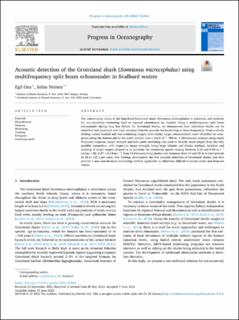Acoustic detection of the Greenland shark (Somniosus microcephalus) using multifrequency split beam echosounder in Svalbard waters
Peer reviewed, Journal article
Published version
Permanent lenke
https://hdl.handle.net/11250/3027053Utgivelsesdato
2022Metadata
Vis full innførselSamlinger
- Articles [3012]
- Publikasjoner fra CRIStin [3070]
Sammendrag
The conservation status of the long-lived Greenland shark (Somniosus microcephalus) is unknown, and methods for non-invasively estimating local or regional abundances are wanted. Using a multifrequency split beam echosounder during long line fishery for Greenland sharks, we demonstrate how individual sharks can be identified and separated with high accuracy from the acoustic backscattering at three frequencies. From a slowly drifting vessel, hooked and free-swimming targets with similar target characteristics were identified on echograms along the bottom and in the water column over a depth of ∼ 400 m. A discriminate analysis using target frequency response, target strength and echo pulse stretching was used to identify shark targets from the only possible competitor, with respect to target strength, being large Atlantic cod (Gadus morhua). Isolation and tracking of single targets allowed us to calculate the swimming speeds ranging between 0.16 and 0.84 m s−1 (mean ± SD, 0.47 ± 0.18 m s−1) from 15 free-swimming sharks over distances from 11 and 50 m in time periods of 28 to 122 s per track. Our findings demonstrate the first acoustic detection of Greenland sharks, and thus provide a new non-invasive monitoring method applicable in otherwise difficult-to-access arctic and deep-sea waters.
